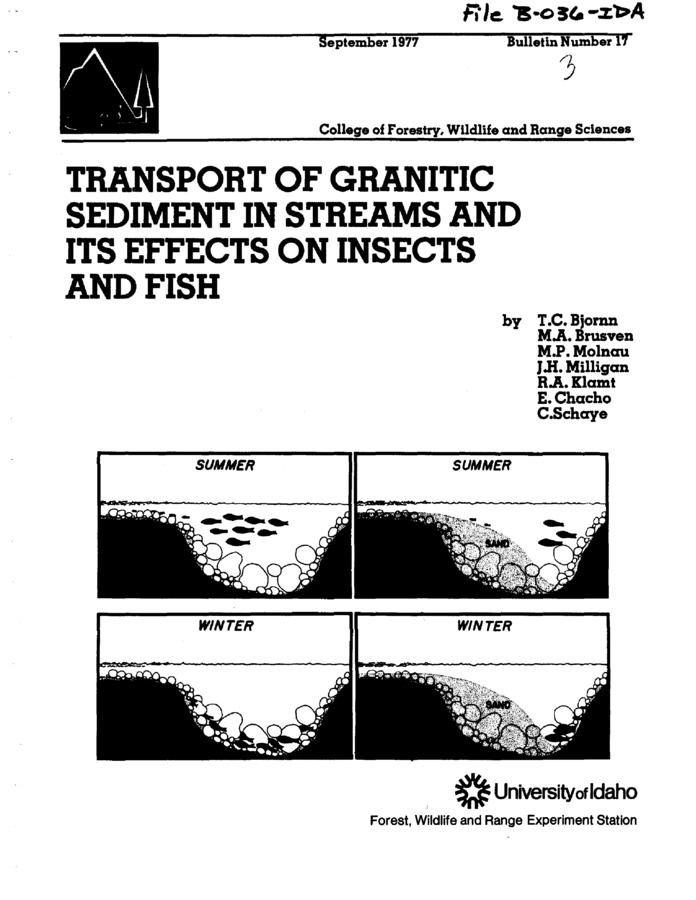PDF
Transport of granitic sediment in streams and its effects on insects and fish. Bulletin no. 17 Item Info
- Title:
- Transport of granitic sediment in streams and its effects on insects and fish. Bulletin no. 17
- Authors:
- Bjornn, T. C.; Brusven, M. A.; Molnau, M. P.; Miligan, J. H.; Klamt, R. A.; Chacho, E.; Schaye, C.
- Contributors:
- Idaho Water Resources Research Institute; IWRRI
- Date:
- 1977-09
- Description:
- We assessed the transport of granitic bedload sediment (< 6.35 mm diameter) in streams flowing through central Idaho mountain valleys and the effects of the sediment on juvenile salmonids and aquatic insects. We measured bedload sediment transported in the streams during the spring snowmelt runoff and the summer lowflow periods for 2 years, to test the applicability of the Meyer-Peter, Muller equation for estimating such transport. In both years the streams transported all the sediment available, including that under the armor layer of the stream bottom in the first year. The modified MeyerPeter, Muller equation proved accurate in estimating the transport capacity of such streams using measurements of slope, hydraulic radius and mean diameter of streambed material. In artificial stream channels, benthic insect density in fully sedimented riffles(> 2/3 cobble imbeddedness) was one-half that in unsedimented riffles, but the abundance of drifting insects in the sedimented channels was not significantly smaller. In a natural stream riffle, benthic insects were 1.5 times more abundant in a plot cleaned of sediment, with mayflies and stoneflies 4 and 8 times more abundant, respectively. Riffle beetles (Elmidae) were more abundant in the uncleaned plot. During both summer and winter, fewer fish remained in the artificial stream channels where sediment was added to the pools. The interstices between the large rocks in the pools provided essential cover necessary to maintain large densities of fish. Fish in sedimented channels exhibited hierarchical behavior, while those in unsedimented channels were territorial in behavior. In small natural pools ( 100 to 200 m^2 ), a loss in pool volume or in area deeper than 0.3 m from additions of sediment resulted in a proportional decrease in fish numbers. We did not, however, find significant correlations between riffle sedimentation and fish density in the two natural streams we studied. Fish abundance was significantly correlated with insect drift abundance in one stream, but not in the other. The amounts of sediment in the two streams studied did not have an obvious adverse effect on the abundance of fish or the insect drift on which they feed.
- Subjects:
- bed load benthos fish sediment transport population density
- Location:
- Knapp Creek
- Idaho County:
- Custer County
- Latitude:
- 44.42
- Longitude:
- -115.02
- Collection:
- IWRRI
- Source:
- Idaho Water Resources Research Institute, University of Idaho
- Identifier:
- IWRRI Number 197701
- Publisher:
- Idaho Water Resources Research Institute, University of Idaho
- Contributing Institution:
- University of Idaho
- Type:
- Text
- Format:
- application/pdf
- Cataloger:
- wbv
- Date Digitized:
- 2012
- Language:
- eng
Source
- Preferred Citation:
- "Transport of granitic sediment in streams and its effects on insects and fish. Bulletin no. 17", Idaho Waters Digital Library, University of Idaho Library Digital Collections, https://www.lib.uidaho.edu/digital/iwdl/items/iwdl-197701.html
Rights
- Rights:
- In copyright, educational use permitted. Educational use includes non-commercial reproduction of text and images in materials for teaching and research purposes. For other contexts beyond fair use, including digital reproduction, please contact the University of Idaho Library Special Collections and Archives Department at libspec@uidaho.edu. The University of Idaho Library is not liable for any violations of the law by users.
- Standardized Rights:
- http://rightsstatements.org/vocab/InC-EDU/1.0/

